![]()
|
 |
A Program of THE ROBERT WOOD JOHNSON FOUNDATION |
After-School Grows Up
Tony Proscio and Basil J. Whiting (October 2004) Available as a PDF only.
Download Report
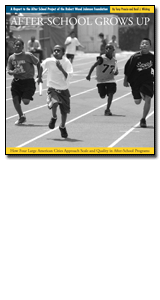 |
In the last decade, initiatives to create, expand and improve afterschool services for young people have become more typical in large cities across the United States. However, the field is still nascent and tremendous challenges remain. Co-authors Proscio and Whiting provide in-depth studies of four cities—Chicago, Los Angeles, New York, and San Diego—who have, over time, developed highly effective afterschool support organizations. While each city's story is set in a unique political and social landscape, there are common elements in their profiles that the Project believes are fundamental to their successes to-date.
The full report may be downloaded in its entirety, or in individual sections.
|
| Afterschool Counts!, A Guide to Issues and Strategies for Monitoring Attendance in Afterschool and Other Youth Programs
Leila Feister/Policy Studies Associates, Inc. (May 2004) Available as a PDF only.
Download Report
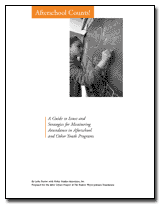 The guide provides practical information on attendance data for program directors. It is intended to raise awareness among funders, policy makers and researchers of the issues and options involved in tracking attendance and participation in out-of-school activities. The guide aims to lay the groundwork for program-level attendance systems that are capable of feeding high-quality data into citywide systems for tracking youth activities. The guide provides practical information on attendance data for program directors. It is intended to raise awareness among funders, policy makers and researchers of the issues and options involved in tracking attendance and participation in out-of-school activities. The guide aims to lay the groundwork for program-level attendance systems that are capable of feeding high-quality data into citywide systems for tracking youth activities.
| Building Quality After-School Programs through Professional Development Intermediaries: A Case Study of The After-School Institute
Prepared by The After-School Institute, with funding from the After School Project (June 2006) Available as a PDF only.
Download Report
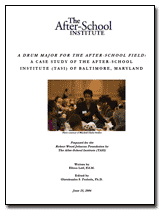 A case study of The After-School Institute summarizing lessons learned by TASI on: recruiting, establishing relationships and providing networking opportunities for after school programs; developing a system for training focusing on increasing quality, quantity and utilization of after school programs; incorporating youth development principles that increases youth leadership and youth engagement; and, assessing impact. A case study of The After-School Institute summarizing lessons learned by TASI on: recruiting, establishing relationships and providing networking opportunities for after school programs; developing a system for training focusing on increasing quality, quantity and utilization of after school programs; incorporating youth development principles that increases youth leadership and youth engagement; and, assessing impact.
| Everyone Plays! A Review of the Research on the Integration of Sports and Physical Activity into Out-of-School Time Programs
Prepared by Policy Studies Associates, Inc. with support from the After School Project (June 2006). Available as a PDF only.
Download Report
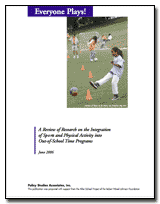 Posing the question, "Can out-of-school time OST sports and physical activity programs become staging grounds for fighting America's battle with youth obesity?," Policy Studies Associates conducted a review of current research on the integration of OST sports and physical activity. The report covers: Posing the question, "Can out-of-school time OST sports and physical activity programs become staging grounds for fighting America's battle with youth obesity?," Policy Studies Associates conducted a review of current research on the integration of OST sports and physical activity. The report covers:
* their role in healthy youth development
* influences on youth participation
* expected outcomes
* characteristics of effective OST programs
* implications for policy and practice
| Healthy Children Healthy Futures Initiative
Prepared by the After-School Institute, with Funding from the After School Project (June 2006) Available as a PDF only.
Download Report
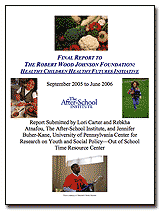 A report on TASI's collaborative effort with the Strang Cancer Prevention Center to implement the Healthy Children Healthy Futures (HCHF) nutrition and physical fitness curriculum in twelve Baltimore afterschool programs as a means of preventing childhood obesity. The report includes an executive summary of a process evaluation conducted by the Out-of-School Time Resource Center at the University of Pennsylvania to determine what factors facilitated successful implementation of the HCHF curriculum in the twelve programs and the role played by an intermediary. A report on TASI's collaborative effort with the Strang Cancer Prevention Center to implement the Healthy Children Healthy Futures (HCHF) nutrition and physical fitness curriculum in twelve Baltimore afterschool programs as a means of preventing childhood obesity. The report includes an executive summary of a process evaluation conducted by the Out-of-School Time Resource Center at the University of Pennsylvania to determine what factors facilitated successful implementation of the HCHF curriculum in the twelve programs and the role played by an intermediary.
| Healthy Choices Afterschool, Investigation of the Alignment of Physical Activity and Nutrition Programs/Curricula and the National Afterschool Association Program Standards
Prepared by the National Institute on Out-of School-Time (NIOST), with funding from the After School Project. (June 2006) Available as a PDF only.
Download Report
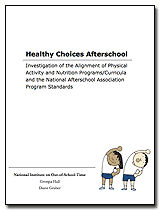 NIOST reviewed and analyzed 20 programs for their alignment with the National Afterschool Association Program Standards. These standards are designed to describe the best practices in out-of-school time programs for children and youth between the ages of 5 — 14 and are used by the Association and out-of-school-time programs throughout the country as a basis for a self-study process and program accreditation
NIOST reviewed and analyzed 20 programs for their alignment with the National Afterschool Association Program Standards. These standards are designed to describe the best practices in out-of-school time programs for children and youth between the ages of 5 — 14 and are used by the Association and out-of-school-time programs throughout the country as a basis for a self-study process and program accreditation
| Making the Most of the Day, The Final Report of the After School Project
Tony Proscio (July 2006) Available as a PDF only.
Download Report
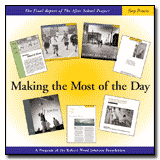 The final report to the field sums up the 5-year pilot. Based on interviews with the leadership of the Project's three sites—Boston After School & Beyond, Chicago's After School Matters, and Team-Up for Youth in the San Francisco Bay Area—the report reflects on the process and progress of their work in their respective cities, the independent conclusion of the Project's evaluation consultant, and on the out-of--school-time field generally, including the opportunities and risks it faces in the remainder of this decade and beyond. The final report to the field sums up the 5-year pilot. Based on interviews with the leadership of the Project's three sites—Boston After School & Beyond, Chicago's After School Matters, and Team-Up for Youth in the San Francisco Bay Area—the report reflects on the process and progress of their work in their respective cities, the independent conclusion of the Project's evaluation consultant, and on the out-of--school-time field generally, including the opportunities and risks it faces in the remainder of this decade and beyond.
| Positive Youth Development And Nutrition In Sports
Study Report by: Cornell University Cooperative Extension New York City, with funding from the After School Project, (June 2005) Available as a PDF only.
Download Report
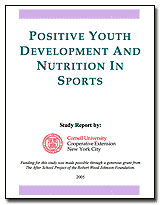 Over 2004-2005, Cornell University's Cooperative Extension-NYC assessed the status of training in the areas of positive youth development, nutrition, and health for volunteer or paid coaches and agency leaders implementing youth sports programs in a variety of settings. The report also documents the content of a select group of large scale, established coach training programs and the gaps that exist in current training initiatives.
Over 2004-2005, Cornell University's Cooperative Extension-NYC assessed the status of training in the areas of positive youth development, nutrition, and health for volunteer or paid coaches and agency leaders implementing youth sports programs in a variety of settings. The report also documents the content of a select group of large scale, established coach training programs and the gaps that exist in current training initiatives.
- Click here the full report (61 pages, 1.5Mb).
- Click here for the Executive Summary (12 pages, 0.5Mb)
| Precious Time: A Report to the Field
Tony Proscio (October 2002) Available as a PDF only.
Download Report
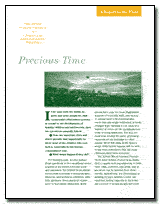 The Robert Wood Johnson Foundation is seeking to learn whether cities can establish lasting capacity to increase the number of young people involved with adults in high-quality activities after school. Proscio gives an in-depth look at the impetus for the Foundation's After School Project. The Robert Wood Johnson Foundation is seeking to learn whether cities can establish lasting capacity to increase the number of young people involved with adults in high-quality activities after school. Proscio gives an in-depth look at the impetus for the Foundation's After School Project.
This report to the field describes the goals of the Project's reconnaissance to select cities that could yield answers to this question and discusses the work of the first two sites to become a part of the Project: Chicago's After School Matters and the San Francisco Bay Area's Team-Up for Youth.
|
|
|



